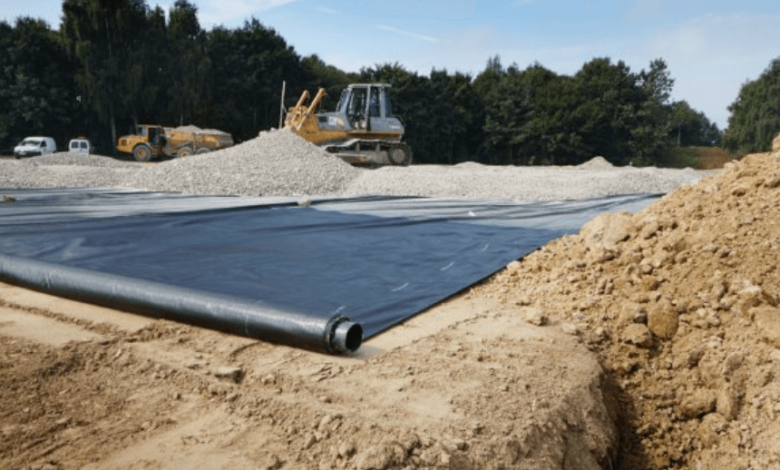Geotextil Impermeabilizante: The Smart Solution for Soil and Water Protection

In modern construction and environmental engineering, materials that offer both functionality and sustainability are in high demand. One such material that is transforming infrastructure projects is the geotextil impermeabilizante—a waterproof geotextile designed to control fluid movement while reinforcing soils. This powerful combination of barrier and strength properties makes it indispensable in applications ranging from road construction to landfills and water management systems.
This article explores the properties, applications, advantages, and types of waterproof geotextiles, helping engineers, contractors, and planners understand why geotextil impermeabilizante is a smart choice for modern infrastructure projects.
What is a Geotextil Impermeabilizante?
A geotextil impermeabilizante is a type of geotextile fabric engineered not only to reinforce soil but also to block the passage of water or other liquids. Unlike standard permeable geotextiles, which allow water to pass through while retaining particles, the impermeabilizante variant includes a layer (often polymeric) that makes it waterproof.
It typically consists of a woven or non-woven geotextile fabric laminated or coated with an impermeable membrane like polyethylene (PE) or polypropylene (PP). This hybrid structure allows it to perform multiple functions such as separation, protection, and impermeability—all within a single layer.
Key Characteristics of Waterproof Geotextiles
Understanding the technical properties of geotextil impermeabilizante helps in choosing the right material for different applications. Key characteristics include:
- Impermeability: Prevents liquid migration through the fabric, ideal for lining and containment.
- Chemical Resistance: Resists degradation from oils, solvents, acids, and alkalis.
- Tensile Strength: Offers excellent reinforcement and load distribution on soft or uneven ground.
- UV Resistance: Withstands exposure to sunlight in uncovered applications.
- Flexibility: Conforms easily to complex geometries such as slopes, corners, and uneven surfaces.
- Thermal Stability: Tolerates a wide range of temperatures without losing performance.
These features make it ideal for both temporary and permanent installations in critical engineering applications.
See also: Construction Hoist Spare Parts: A Critical Asset for Safe and Efficient Vertical Transport
Applications of Geotextil Impermeabilizante
The use of geotextil impermeabilizante spans a wide range of industries due to its dual ability to reinforce and seal. Some of the most common applications include:
1. Landfills and Waste Containment
Waterproof geotextiles are used as liners or cover systems to prevent leachate from escaping into the ground and contaminating groundwater.
2. Canal and Reservoir Liners
In water retention structures like irrigation canals, ponds, and reservoirs, they serve as impermeable barriers to prevent seepage.
3. Tunnels and Underground Construction
They are used in tunnel linings to prevent groundwater infiltration and protect the structure from moisture damage.
How It Differs From Regular Geotextiles
While traditional geotextiles focus primarily on filtration, separation, and reinforcement, geotextil impermeabilizante adds a critical barrier function to the mix. Here’s how they differ:
| Feature | Standard Geotextile | Geotextil Impermeabilizante |
| Water Permeability | High | Near Zero |
| Primary Use | Separation/Filtration | Barrier & Protection |
| Coating Layer | None | Polyethylene/Polypropylene |
| Applications | Drainage, Erosion Control | Containment, Seepage Prevention |
By incorporating an impermeable layer, it can achieve what typical geotextiles cannot—fluid retention and redirection without additional membranes.
Installation Guidelines
Proper installation of geotextil impermeabilizante is crucial to ensure its effectiveness. The process generally involves the following steps:
- Site Preparation: Remove debris, sharp objects, and level the surface to avoid punctures.
- Unrolling: Lay the rolls carefully to avoid folds or wrinkles, ensuring full contact with the ground.
- Overlap & Seaming: Overlap adjacent sheets (usually by 30–50 cm) and bond them via heat welding or adhesive sealing for continuity.
- Anchoring: Secure the edges using trenching or mechanical anchoring to prevent movement.
- Protection Layer: Cover with soil, gravel, or geogrid if required for added protection, especially in load-bearing applications.
Following manufacturer guidelines during installation ensures long-lasting performance and minimizes failure risks.
Advantages of Using Geotextil Impermeabilizante
The use of waterproof geotextiles offers multiple benefits that contribute to sustainable and cost-effective infrastructure development:
- Reduces Construction Time: Combines barrier and reinforcement functions, reducing the need for multiple layers.
- Minimizes Environmental Impact: Prevents contamination of soil and water sources.
- Improves Structural Life: Protects underlying layers from water damage and erosion.
- Low Maintenance: Once installed correctly, it requires minimal upkeep over its lifespan.
- Cost-Effective: Reduces long-term repair costs and extends the durability of roads, landfills, and water systems.
Types of Geotextil Impermeabilizante
There are several types of waterproof geotextiles available, categorized based on structure and material:
1. Laminated Geotextiles
These have a membrane laminated onto a geotextile base, offering high strength and durability.
2. Coated Geotextiles
Made by spraying or dipping the geotextile in a polymer to block pores and make it waterproof.
3. Geosynthetic Clay Liners (GCLs)
Although not technically a geotextile, GCLs combine bentonite clay and geotextiles to offer similar impermeability and reinforcement.
The choice depends on the specific needs of the project, such as load requirements, exposure conditions, and chemical environment.
Future of Waterproof Geotextiles
With increasing environmental regulations and the need for sustainable infrastructure, the use of geotextil impermeabilizante is expected to grow significantly. Innovations such as biodegradable coatings, smart materials with sensing capabilities, and improved recyclability are on the horizon.
These advancements will make waterproof geotextiles even more integral in flood control, green roofing systems, smart highways, and climate-resilient construction.
Final Thoughts
The geotextil impermeabilizante is not just a construction material—it’s a solution. With its ability to reinforce soil and act as a fluid barrier simultaneously, it offers unmatched versatility for modern engineering challenges. Whether it’s keeping water out of a foundation, lining a reservoir, or protecting the environment from landfill runoff, waterproof geotextiles deliver performance, sustainability, and value.
As civil and environmental engineers look for better ways to build responsibly, geotextil impermeabilizante stands out as a critical innovation in the world of geosynthetics.



